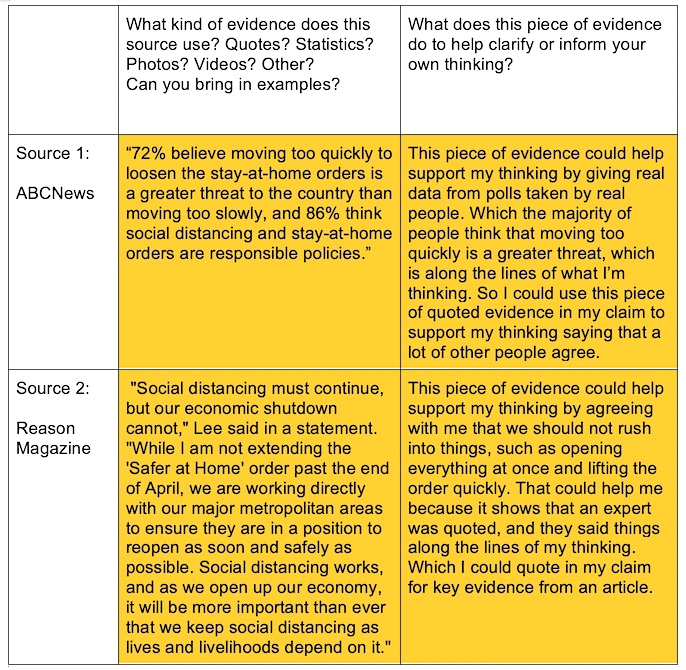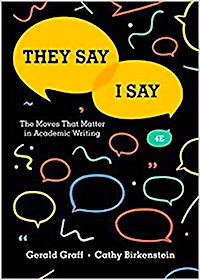Sentence-Starter Scaffolds Propel Argument Writing
A MiddleWeb Blog

In this post I want to pick up the thread and focus on the part of our lesson planning where we had students examine evidence they found in two articles they have read on the same topic (Covid-19 and reopening our country) – one from a more moderate to liberal source and the other from a conservative source.
I’ll also discuss how students began drafting their argument writing with the use of sentence starters – a form of scaffolding. This activity can be adapted to any classroom, and although it worked well for me, not every piece of it may work well for you. Enjoy!
Where We Left Off
In my last post, I concluded with students looking at word clouds that were created from each article they read. The idea behind using word clouds was to make students aware that different articles intentionally focus on certain wording to help persuade readers, depending on whom the target audience may be.
In the specific student example that I provided, the wording had not persuaded the student to take a different position. However, by showing students the frequency in which words are being used in articles, we opened the door to having some great conversations about how media can be persuasive.
Final Parts of the Lesson
After the students explored the vocabulary used in the two articles, the lesson shifted focus. Now students started to think about how the pieces of evidence from each article would help them develop their argument.
To accomplish this, students had to establish a firm position on the given topic. This can be rather difficult if they don’t take time to gather evidence to support their claim/position.
Below is a table students filled in for each article. What is particularly useful and requires students to dive deeper into their argumentative thought process is the question: “What does this piece of evidence do to help clarify or inform your own thinking?”
Is the student actually making an informed decision about the position they have chosen to take, based on the articles they have read? Also, does the student believe the evidence provided is accurate enough for them to take their position?
Framed this way, students will need to think further through the pieces they’ve accumulated to effectively write their argument paper. This particular step helps narrow their focus as they approach the writing stage of the process.
This student’s responses indicate they found enough information in each article to support whichever position they might take on the topic. Because the student pulled out specific information that could support their claim, it helped them get further in the writing process when they began drafting their argument. There was no getting “stuck” at the point when it was time to include evidence for their claim – or state a reason why their evidence supported their claim. They already had it on hand.
Starting With Sentence Starters
For the final part of the activity, students were given sentence starters to help them begin drafting their argument pieces. The idea of using sentences starters is not new, and I have used this strategy effectively before with middle grades students at every grade level.
Anyone who has read Graff and Birkenstein’s They Say/I Say: The Moves That Matter in Academic Writing knows how powerful and helpful this professional text (now in its 4th edition) can be for teachers of any age range. The book provides many templates to help guide teachers in their quest to make students better writers of nonfiction and argument.
Graff and Birkenstein specifically discuss the use of sentence starters in their book. The strategy has not only changed my instructional approach to writing in my classroom, but it has jump-started many of my students who always tend to say, “I don’t know how to begin, Mr. Hyler.” Below are the sentence starters Dr. Hicks used with my students. The sentences starters can be changed and adapted to fit a particular teaching situation.
When it comes to the topic of when to re-open America after the worst of the COVID-19 crisis is over, most of us will readily agree that __________.
- Where this agreement usually ends, however, is on the question of _____________.
- On the one hand, ABCNews reports that _____________,
- On the other hand, Reason Magazine reports that ______________.
- My own view is ______________ because ______________.
And here are some student responses using the sentence starters:
► When it comes to the topic of when to re-open America after the worst of the COVID-19 crisis is over, most of us will readily agree that it will need to happen sooner or later, but not too quickly. We should still take precautions in the reopening of things and work slowly on opening them, but it will eventually need to happen.
► Where this agreement usually ends, however, is on the question of how we should approach the reopening. For example, which things should we allow reopening first, second and so on.
► On the one hand, ABCNews reports that 72% of people see more risk for the country in moving too quickly than too slowly (28%). Also, 80% support social distancing and the stay-at-home orders compared to the 20% who believe they are a government overreach,
► On the other hand, Reason Magazine quotes Lee that “Social distancing must continue to happen, but our economic shutdown should not.”
► My own view is that we should still social distance ourselves and start reopening things, but not too quickly because if we reopen too quickly, we could have a worse, more deadly, blast of this coronavirus when everything reopens and everybody goes out like nothing happened. Like I just said, this could lead to even more people getting the virus and even more people dying from the virus than the first time.
Giving the students the sentence starters propelled them to write with more clarity and structure. Their responses on average would have been less successful if I had just told them to start writing. Too many times early in my teaching career I told students to just “figure it out” and the resulting writing was pretty terrible. Now students have a template or framework to help them relax and move through their writing more thoughtfully.
Giving them sentence starters is not giving them the answers. It is giving them some scaffolding that helps them produce writing of good quality they can be proud of, and I can be proud to read as their teacher. If you have not ever checked out They Say/I Say, I highly recommend it.
Closing Thoughts
When Troy Hicks first approached me about doing this argument writing activity with my 6th grade students, I was hesitant. I thought it would be too overwhelming for them. However, I also knew that during the beginning of the pandemic, I wanted to be able to reach my students with quality instruction and not just throw online worksheets at them.
After a few discussions, Dr. Hicks and I formulated a plan and delivered it to my 6th graders. My students didn’t disappoint. I don’t say this to brag, I say it because the approach that was taken to teach students about argument writing during virtual learning was a success. It has been these small successes that have elevated me through these difficult times. We all need small victories and celebrations with our students to get through this pandemic.
Finally, I want to leave you with this thought. Our world has been going through this pandemic through the better part of a year now. It seems like an eternity for educators.

What I am sharing with you is not necessarily a “Best Practice,” but it worked for me. What is best for me may not be best for other teachers. Please take and use what works for you and find your own “Best Practice.”
































